
The Darwin D. Martin House is a historic house museum in Buffalo, New York. The property's buildings were designed by renowned architect Frank Lloyd Wright and built between 1903 and 1905. The house is considered to be one of the most important projects from Wright's Prairie School era.

The Newport Casino is an athletic complex and recreation center located at 180–200 Bellevue Avenue, Newport, Rhode Island in the Bellevue Avenue/Casino Historic District. Built in 1879–1881 by New York Herald publisher James Gordon Bennett, Jr., it was designed in the Shingle style by the newly formed firm of McKim, Mead & White. The Newport Casino was the firm's first major commission and helped to establish the firm's national reputation. Built as a social club, it included courts for both lawn tennis and court tennis, facilities for other games, such as squash and lawn bowling, club rooms for reading, socializing, card-playing, and billiards, shops, and a convertible theater and ballroom. It became a center of Newport's social life during the Gilded Age through the 1920s.

The Edgewater Beach Hotel was a resort hotel complex on Lake Michigan in the far-north neighborhood community of Edgewater in Chicago, Illinois, designed by Benjamin H. Marshall and Charles E. Fox. The first multi-story building was built in 1916, for its owners John Tobin Connery and James Patrick Connery, located between Sheridan Road and Lake Michigan at Berwyn Avenue in a Spanish Revival style. An adjacent south tower building was added in 1924, with a low connecting passageway-building to serve as reception and additional public rooms. The resort, which included beaches, pools, clubs, and gardens hosted famous movie and sports stars, and later Martin Luther King Jr. The hotel was also the setting for the celebrity stalking case and shooting that inspired the novel and movie The Natural. The hotel buildings closed in 1967, and were soon after demolished.

Whitehall is a 75-room, 100,000 square foot Gilded Age palace type mansion open to the public in Palm Beach, Florida in the United States. Completed in 1902, it is a major example of neoclassical Beaux Arts architecture designed by Carrère and Hastings for Henry Flagler, a leading captain of industry in the late 19th century, and a leading developer of Florida as a tourist destination. The building is listed a National Historic Landmark. It now houses the Henry Morrison Flagler Museum, named after its builder.

Midway State Park, located in Maple Springs, New York, was established in 1898 by the Jamestown & Lake Erie Railway as a picnic ground. Today, it is recognized as the fifteenth-oldest continually operating amusement park in the United States, and the fifth-oldest remaining trolley park of the thirteen still operating in the United States.
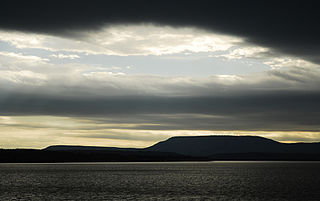
Located near Dardanelle, Arkansas and rising about 1,350 feet (410 m) above the mountain valleys of west-central Arkansas to an elevation of about 1,755 feet (535 m) above sea level, Mount Nebo has views of 34,000 acres (140 km2) Lake Dardanelle, the Arkansas River and the surrounding mountain ridges. Atop this biblically named plateau is Mount Nebo State Park. Developed as a resort area in the late 19th century, it became a state park in 1928, its early development spearheaded by the Civilian Conservation Corps. Park activities include hiking, camping, and other outdoor pursuits.

Jules Jacques Benois Benedict was one of the most prominent architects in Colorado history, whose works include a number of well-known landmarks and buildings listed on the National Register of Historic Places.

Hot Lake Hotel is a historic Colonial Revival hotel originally built in 1864 in Hot Lake, Union County, Oregon, United States. The hotel received its namesake from the thermal spring on the property, and operated as a luxury resort and sanitorium during the turn of the century, advertising the medicinal attributes of the mineral water and drawing visitors worldwide. It is also the first known commercial building in the world to utilize geothermal energy as its primary heat source.
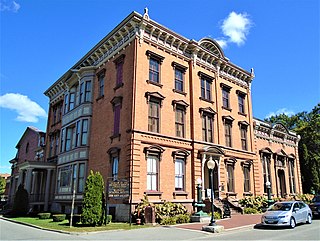
Canfield Casino and Congress Park is a 17-acre (6.9 ha) site in Saratoga Springs, New York, United States. It was formerly the site of the Congress Hotel, a large resort hotel, and the Congress Spring Bottling Plant, as well as Canfield Casino, which together brought Saratoga Springs international fame as a health spa and gambling site. At the peak of its popularity it was a place where the wealthy, major gamblers and stars of the entertainment world mingled. The park's artwork includes a statue by Daniel Chester French and landscape design by Frederick Law Olmsted, among others.

The Sheridan Inn is a historic hotel in Sheridan, Wyoming. Designed by the architect Thomas R. Kimball of Omaha, Nebraska in 1893, it was constructed by the Chicago, Burlington, and Quincy Railroad as part of its development program in Wyoming associated with extension of the railway. Equipped with the first bathtubs and electric lights in that part of Wyoming, the inn was considered the "finest hotel" between Chicago and San Francisco. It was declared a National Historic Landmark in 1964.

The William Paca House is an 18th-century Georgian mansion in Annapolis, Maryland, United States. Founding Father William Paca was a signatory of the Declaration of Independence and a three-term Governor of Maryland. The house was built between 1763 and 1765 and its architecture was largely designed by Paca himself. The 2-acre (8,100 m2) walled garden, which includes a two-story summer house, has been restored to its original state.

The Cass Park Historic District is a historic district in Midtown Detroit, Michigan, consisting of 25 buildings along the streets of Temple, Ledyard, and 2nd, surrounding Cass Park. It was listed on the National Register of Historic Places in 2005 and designated a city of Detroit historic district in 2016.

The Park Avenue House is a high rise residential building located at 2305 Park Avenue in the Park Avenue Historic District in Downtown Detroit, Michigan. It was listed on the National Register of Historic Places in 1996. It should not be confused with the nearby Park Avenue Hotel, which was demolished in 2015.
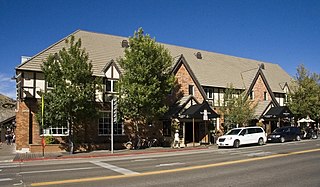
The Wort Hotel was built in downtown Jackson, Wyoming, United States by brothers John and Jess Wort, who were significant figures in the transformation of the economy of Jackson Hole from ranching to tourism. The somewhat Tudor-style building was the first luxury hotel in Jackson. The two-story building features brick facing, with half-timbering and stucco on the second floor and a series of gables facing the street.

The Outing Club is located in the central part of Davenport, Iowa, United States. It has been listed on the National Register of Historic Places since 1977. In 1985 it was included as a contributing property in the Vander Veer Park Historic District.
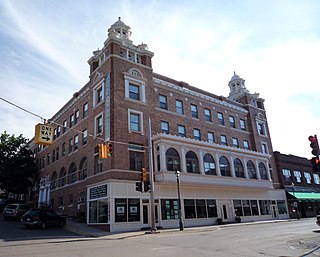
The Douglass House is a hotel located at the corner of Shelden Avenue and Isle Royale Street in Houghton, Michigan. It was placed on the National Register of Historic Places in 1982.
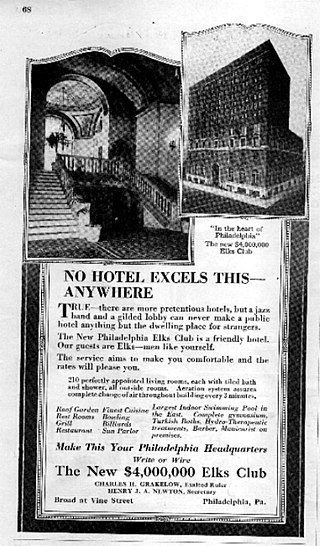
The Philadelphia Lodge No. 2 BPOE, also known as the Philadelphia Athletic Club, was a historic American Benevolent and Protective Order of Elks (BPOE) lodge that occupied 306-320 North Broad Street in the Logan Square neighborhood of Center City Philadelphia.

The Hotel Wolf is a hotel and restaurant in Saratoga, Wyoming. The two-story brick building was built at an estimated cost of $6000 in 1893 for Frederick G. Wolf, a German immigrant who had operated liquor stores in Wyoming. It opened for dining with a banquet on New Year's Eve 1893. The hotel opened on January 10, 1894. Two years after Wolf's death in 1910 his widow Christina sold the property to George W. Sisson for $10,000. It continues to operate as a hotel and restaurant.

The Hotel Higgins, Tabor Hotel or Higgins Hotel was built in 1916-1917 during the oil boom in Glenrock, Wyoming. It was built for John E. Higgins, who was a local rancher, legislator and oil business investor, and his wife Josephine Amoretti Higgins. It was designed by architect Edward Reavill, and it opened on May 9, 1917. After the accidental death of Josephine in 1924 and the death of John in 1926 the property was disputed by their heirs. This was resolved in 1942 when the hotel was sold to Dr. and Mrs. Leonard Tabor at a tax sale, and the hotel became the Tabor Hotel. After several new owners the hotel became the Hotel Higgins again in 1978.

The Outlaw Inn in Rock Springs, Wyoming, at 1630 Elk St., was listed on the National Register of Historic Places in 2018.





















